Blog
Dishes only in Vietnam: Strangest specialties that might surprise you

Please log in to continue

Dishes only in Vietnam: Strangest specialties that might surprise you
April 30, 2021
The cuisine has always been like an endless source of creativity for Vietnamese and each region has very unique cuisine features. Vietnamese cuisine has a lot of strange dishes that might surprise guests but they are actually very delicious and healthy. Here is a list of some of the most bizarre dishes in Vietnam.
Trung Vit Lon is basically a developing duck embryo. It is one of those “snacks” in Vietnam and people consider it to be very nutritious. Trung Vit Lon is also common in other Southeast Asia countries such as the Philippines and Cambodia, though the cooking process might be a bit different.

Trung Vit Lon is usually eaten with laksa leaves
Trung Vit Lon in Vietnam is usually a boiled embryo that is about 9 - 11 days old. When the egg is well-cooked, people crack it into a small bowl and eat it together with laksa leaves, ginger slices, salt, and pepper. Some regions like Da Nang even eat it with a sour and sweet sauce made of papaya. Some foreigners are afraid to try, some even feel disgusted which is understandable because you can see the shape of a baby duck in the middle of developing. They find Trung Vit Lon so terrifying that sometimes it appears in the show Fear Factor.
Tiet Canh is a fresh dish in which the main ingredient is the very blood of an animal. The cooks then put this blood in with fish sauce or dilute salt water to stop coagulation. Next, they mix the blood with some chopped meat or cartilage to make it solid and there we have Tiet Canh. Cooking animals’ blood into Tiet Canh is very common across Vietnam. However, we never really see any other countries processing blood this way, even in Vietnamese communities overseas.
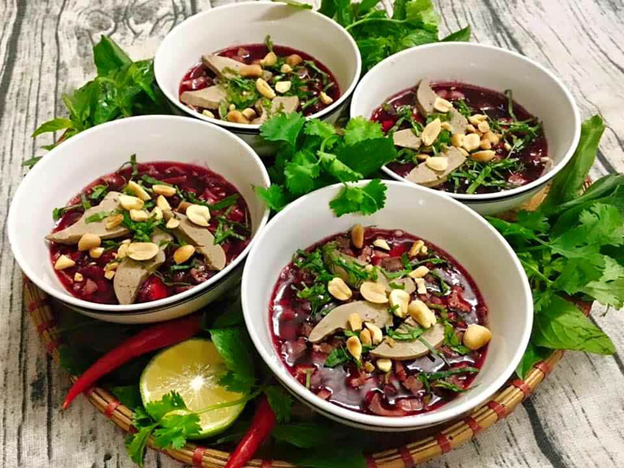
Tiet Canh is a very common dish in Vietnamese cuisine
Tiet Canh is mainly the blood of pigs, geese, ducks, goats, and even dogs. Vietnamese people usually eat Tiet Canh with roasted peanuts, pepper, herbs, and lemon juice. This is a very popular dish for a drinking night in Vietnam. However, recently, authorities have banned selling Tiet Canh as it, though rarely, has caused some deaths. It sure tastes good but it looks very scary so Tiet Canh is in the top scariest dishes in the world.
If you are in Hue for the first time, you will surely be curious about Com Am Phu on the menu. Order one and you’ll be surprised at its decoration and its wonderful taste. Despite the ghostly name, Com Am Phu is one of Hue’s favorite dishes.
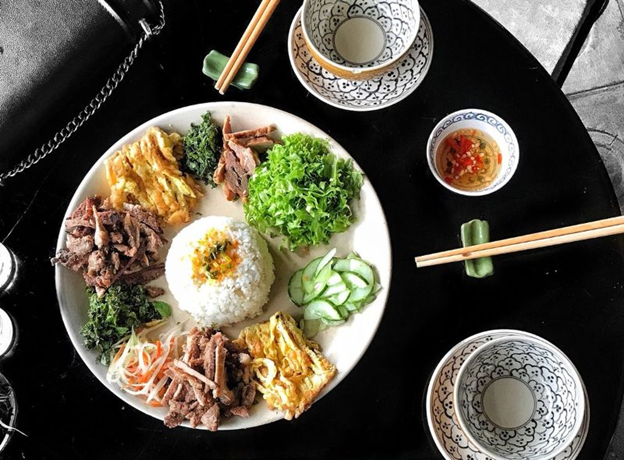
Com Am Phu sounds ghostly but they are very colorful
The ingredients of this dish are very diverse: there are sliced fried eggs, fermented pork rolls, meat rolls, grilled meat, cucumber, roasted shrimps, and so on. The rice used to cook Com Am Phu is very famous for its pleasant flavor and scent. The cooks place the ingredients around the plate to make it look more appetizing. It is essential to eat Com Am Phu with a special type of fish sauce that is mixed with chopped garlic, sugar, and lemon juice. Sprinkling the sauce onto the plate and mixing all the ingredients will enhance the taste that you won’t be able to resist.
We know you are imagining some sorts of rocks and wondering how it is possible to eat rocks. The truth is that the name of this dish originates from the way people cook this dish. The famous Soi Mam of Hau Giang is actually boar meat but people cook it in a special way. Each plate of Soi Mam includes around 3-4 preheated stones. After seasoning the boar meat thoroughly, the cooks put it on the stones. The heat from the stones will cook the meat.
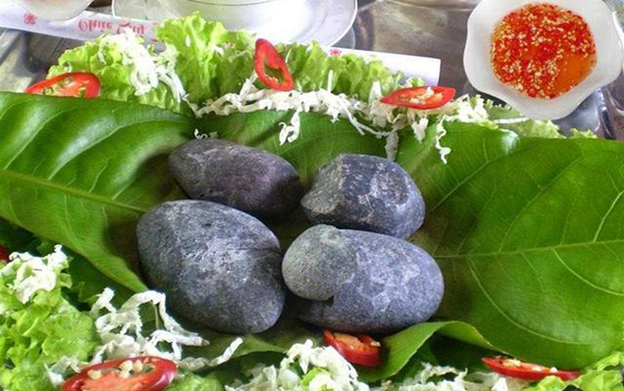
The stones are so hot that they can cook meat
To the people in Hau Giang, Soi Mam is not a formal dish that needs a lot of fussy preparation. But without the stones, Soi Mam won’t the same. A perfect plate of Soi Mam requires the talented hands of the chefs. The boar meat can’t be any kind of meat. It has to be boars that are raised freely on the mountainous areas and the weight has to be in the range from 5-15kg. Otherwise, Soi Mam won’t be as delightful as the meat will be very fatty.
Nam Pia is a traditional specialty of Thai people in the Northwestern regions of Vietnam. They usually serve it on special occasions such as festivals or to welcome guests.
“Nam” in Nam Pia means soup in Thai people’s language, while “pia” is the viscous fluids inside the small intestines of buffaloes, cows, or goats. Yes, it’s just another way to call young feces. To make Nam Pia, Thai people mix organs of the animals and cook with bones until it is sweet enough. They season Nam Pia with a lot of things including chili, garlic, and cocoon. This dish does not look appetizing to anyone, to be honest. The bitterness of some forest leaves and the unpleasant smell of the offal cause discomfort for a lot of people. But still, it is a famous specialty in these regions.
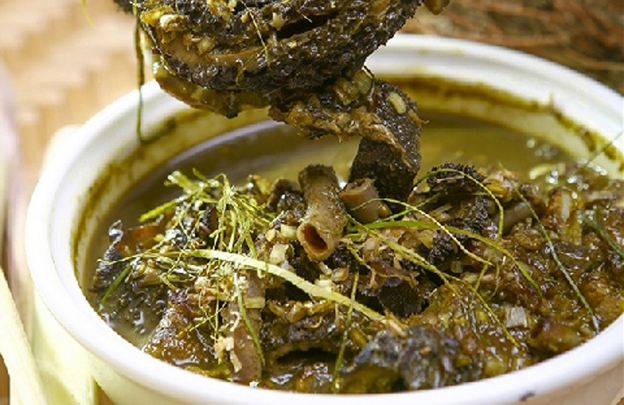
Nam Pia does not look very appealing to guests
Mice, especially voles, are a very common ingredient in Vietnamese cuisine. They are a specialty in many restaurants. In a few Northern regions of Vietnam, the dishes made from mice are indispensable on many special occasions.

Many people are afraid of eating mice
Voles may cost more than 100,000 VND (about 5 USD) per plate. There are more than 30 dishes that are cooked with voles: roasted voles, steamed voles with lemon leaves, stir-fried voles with garlic and onions, fried voles with salt, and so on.
This is one of the most significant dishes of Ha Giang that any tourists should at least taste once. There are a lot of ingredients that create many different flavors in just one bowl of Chao Au Tau: the flavor of “au tau”, the flavor of herbs, meat,...
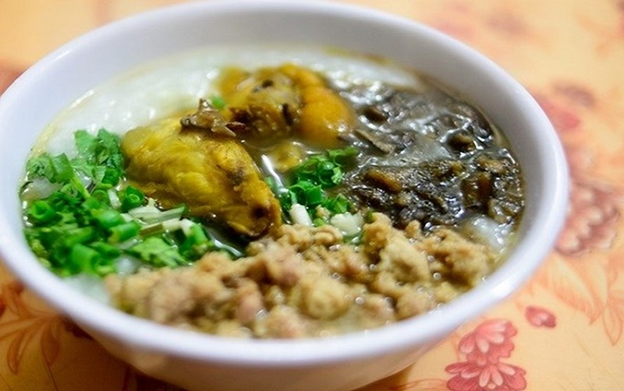
Chao Au Tau is a Ha Giang’s specialty
Cooking this dish takes a lot of time. After washing “au tau” in the water, the cooks stew them in 4 hours. Next, they mix the stewed “au tau” in with different types of rice and pork and then they season it. The porridge has a bitter taste because of “au tau”, so it is called bitter porridge.
Not only is it something to eat, but Chao Au Tau also acts as a medicine to cure sickness. And the special thing about this dish is that it’s only sold at night. Many recommend enjoying Chao Au Tau in the cold winter of Ha Giang.